GEMS, MINERALS and FOSSILS
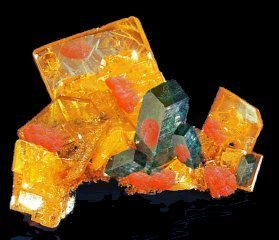 |
I've been a casual rock collector for some time - but have recently begun to collect with more vigour! These are some of the stones currently in my possession (scanned or digitally photographed). Some of these are tumbled stones; others raw, rough material. It's very difficult to accurately convey the colours of these specimens, using these methods - and, in most case, the colour is "faded" - therefore, try to imagine them brighter and, in a lot of cases, darker!! I am only interested in gems, minerals and fossils for their aesthetic qualities and also by their geological aspects. However, I include healing properties in each write-up as I realise others might be interested in them. This page is rather image intensive, as would be expected. The wait should be well worth it! However, there are so many images and so much information crammed onto this one page, that I must make an effort to sort it out a bit. Bear with it in the meantime! |
First! Some lessons!!
What is GEOLOGY?Geology is simply the study of the earth. Physical geology is the study of the earth's composition and the forces that shape the earth's surface. Historical geology is the study of the earth's history and the evolution of land and life forms. (Geology Link Page)
The Structure of the Earth The earth is essentially a large rock with a hot, molten central core. Chemical reactions at the sun-like core produce heat and keep the surrounding rock liquified. The molten rock cools and solidifies away from the hot core and forms a hard crust at the earth's surface. The crust of rock on the surface of the earth is 15-40 miles thick (24-64 km). It is composed of a number of large rock plates - called tectonic plates - that are squeezed together tightly and held in place by the planet's gravity. The plates 'float' on the softer inner crust and are constantly moving and shifting against each other. Where the plates push together, mountain ranges form. When they slide against each other, earthquakes happen. Volcanoes indicate places where cracks, called 'fissures', allow molten rock to rise from the hot core of the planet to the surface. The Rock Cycle
While most people think of rocks as static, inanimate objects, they have a dynamic 'life' cycle and undergo continual transformation. 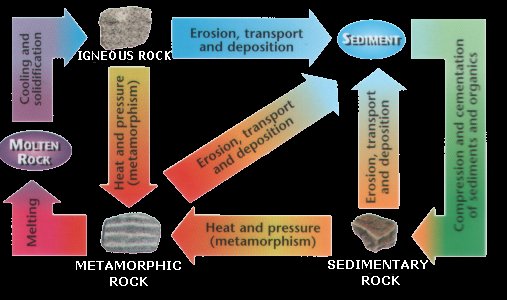 What are ROCKS? Rocks are the hard part of the earth and range in size from sand grains to pebbles, stones, boulders, mountains, islands and continents. Rocks are made up of variable mixtures of mostly inorganic minerals that are bound together in a variety of ways. The earth produces rocks in three different ways. Igneous Rocks Igneous rocks are formed when molten rock is either ejected directly onto the earth's surface (extrusive rock) or pushes up near the surface and cools beneath it (intrusive rock). Examples of extrusive igneous rocks: obsidian, basalt, pumice. Examples of intrusive igneous rocks: granite, gabbro, granite porphyry. Molten rock beneath the earth's crust is called magma, when magma is ejected through the crust it is called lava. Sedimentary Rocks Sedimentary rocks are composed of small bits of rock (mud, sand, gravel) and sometimes plants and/or animals, that become 'cemented' together in layers over time. Examples: mudstone (shale), sandstone, limestone. Metamorphic Rocks Metamorphic rocks are created when existing igneous or sedimentary rocks are squashed, stretched and/or cooked and change their appearance and mineral composition. Examples: gneiss, quartzite, slate, mica schist, marble.
What are MINERALS?
Minerals are solid substances that make up the rocks in the earth's crust. Each mineral is composed of a unique combination of one or more chemicals. Quartz, for example, is always made up of the chemical elements silicon and oxygen and there is always one atom of silicon for every two of oxygen. Of the 92 elements found in the earth's crust, eight account for about 98% of the crust weight - O, oxygen (46%), Si, silicon (28%), Al, aluminium (8%), Fe, iron (5%), Ca, calcium (3.6%), Sn, sodium (2.8%), K, potassium (2.6%), and Mg, magnesium (2%).
Minerals can be generally classified into two broad groups:
1. Metallic minerals - includes pure metals, such as silver, or compounds containing metals, like ores. Rocks containing enough useful minerals to make them commercially valuable are known as ores. Metallic minerals are usually extracted by crushing rocks and heating them until the metal flows out. Examples of Metallic minerals are silver, gold, copper, sphalerite, pyrite, magnetite, galena, limonite and hematite;
and
2. Non-Metallic minerals. Examples: quartz, mica, calcite, suphur, graphite, dolomite, tourmaline, gypsum, talc.
Minerals can be identified by noting the following characteristics:
1. Colour. What colour is it? Is it opaque or translucent?
2. Lustre. Is it shiny or dull? Does it have a metallic or non-metallic lustre?
3. Texture. Is it smooth, bumpy, sugary or jagged?
4. Hardness. The Mohs' Hardness Scale ranks the hardness of minerals from 1-10 with talc being the softest and diamond being the hardest. You can test the hardness of some minerals by scratching them with common items like a fingernail (hardness (H) of 2.5), a penny (H=3), a piece of glass or a knife (H=5.5) and a steel file (H=6.5).
5. Crystalline Structure. Does it have a crystal shape? How many sides does the crystal have? Are they smooth or grooved on the outside? Are they long and slender or stubby?
6. Specific Gravity. Is it unusually heavy or light?
7. Streak. What is the colour of the mineral when it is ground into a powder? Streaks of many minerals can be tested in the field by rubbing them on a peice of unglazed porcelain.
For example, gold is described as a golden yellow, opaque mineral with a metallic lustre and a hardness of 2.5-3. Its crystals are cube-shaped, but gold typically occurs as grains, flakes or a wiry mass. It is unusually heavy (specific gravity of 19.3) and has a golden yellow streak.
What are GEMSTONES?
Most gemstones are rare minerals used in jewellery and ornaments. The only non-mineral substances considered gems are amber (fossilised tree resin), coral (fossilised sea creatures) and pearl (formed in oysters). Most gemstones are formed as a result of intense heat and pressure inside the earth and are found in igneous and metamorphic rocks. When mined, gemstones typically have a rough texture. Skilled artists cut, shape and polish gemstones to create jewels and gems. Most gemstones aren't perfect enough to be made into jewels and are put into a variety of other uses. Diamonds, for example, which are the hardest substance on earth and can be sharpened finer than a razor, are used in industrial tools ranging from oil field drills to surgical instruments.
What are FOSSILS?
Fossils are the preserved remains of animals and plants that died long ago. In most cases, the hard parts of the organism (like teeth, bones and wood) become infused with minerals, making them rock-like. Fossils preserve the imprints of organisms in stone for thousands to hundreds of millions of years.
| AGATE
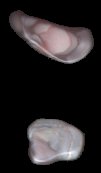
| No gemstone is more creatively striped by nature than agate, chalecedony quartz that forms in concentric layers in a wide variety of colours and textures. Each individual agate forms by filling a cavity in host rock. As a result, agate often is found as a round nodule, with concentric bands like the rings of a tree trunk. The bands sometimes look like eyes, sometimes fanciful scallops, or even a landscape with dendrite trees. Hardness: 7 Other characteristics
Aids competitors in all sporting events, particularly athletes. Also assists eloquence and writing. Ancient legend says it could make the wearer invisible. Used by healers to cure: fevers, gums, circulation.
Agate was highly valued as a talisman or amulet in ancient times. It was said to quench thirst and protect from fevers. Persian magicians used agate to divert storms.
|
| AGATE GEODE 
| What Is A Geode?
The mysterious earth-shaped geodes have long challenged geologist to explain how they are formed. Geodes are a variable phenomenon and, therefore, many theories exists to explain how they are created. The term geode is derived from the Greek word Geoides which means "earthlike."
A geode is a sphere shaped rock which contains a hollow cavity lined with crystals. A geode which is completely filled with small compact crystal formations such as agate, jasper or chalcedony is called a nodule. The only difference between a geode and a nodule is that a geode has a hollow cavity, and a nodule is solid.
How Geodes Are Created
Geodes begin as bubbles in volcanic rock or as animal burrows, tree roots or mud balls in sedimentary rock. Over time, the outer shell of the spherical shape hardens, and water containing silica precipitation forms on the inside walls of the hollow cavity within the geode. The silica precipitation can contain any variety of dissolved minerals, the most common being quartz, but amethyst and calcite are also found.
Over a period of thousands of years, layers of silica cool, forming crystals of different minerals within the cavity. Different types of silica cool at varying temperatures, thus creating layers of different types of mineral crystals.
Each geode is unique in composition and can only be truly discovered when cracked open or cut with a rock saw. The size and formation of crystals and different shades of color within the crystals make each geode special. The rough exterior of the geode gives no indication of the secrets held within its core.
(Thanks to  for this information.) for this information.)
My geode is actually much redder than the photograph can tell you. (It is also MUCH larger!). The quartz crystals inside are very pink. However, it is likely that this geode has been dyed as this is a common practice to enhance the natural colour. Agate is extremely porous.
|
|
MY ROCKS| AMBER

Copal amber (from Colombia)
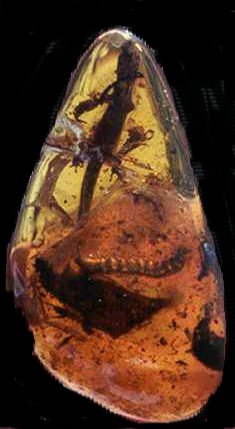
this nice hunk of amber, complete with fossilized lizard is available to purchase from Amberica West - and would set you back a mere $70,000!!!! | Amber is the hardened resin of coniferous and angiospermous trees.Resin is not to be confused with sap which is a product of photosynthesis that consists of sugars, water and dissolved minerals. The sticky extrusive mass that comes from a cut on a pine tree is resin. Under the proper conditions the resin undergoes certain physical and chemical changes that turn it into amber. Amber is said to aid depression.

Visit Gary Platt's "Amber Home" HERE. Very informative and dedicated site.
Also, Susie Ward Aber's "World of Amber"
|
| | AMETHYST

amethyst (2 rough [one from Scotland] + a tumbled stone)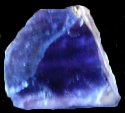
another very rough piece

not mine!
| A variety of quartz (silicon dioxide).
Its purple colouring is caused by
impurities of iron or manganese
compounds.
Hardness: 7. Other characteristics A stone popular among the Ancient Greeks, who believed that drinking from amethyst cups and plates would prevent drunkenness and overeating. Also used by Roman wives to keep husbands faithful.
- Traditionally, amethysts are supposed to guard England's rulers against contagious diseases.
- Amethyst has been used to symbolize deep love, happiness, humility, sincerity, and wealth.
- The earliest known reference to amethyst is in a fourth century B.C. book On Stones.
- Long, ago, farmers believed that wearing amethyst would protect their crops from hailstones and locusts.
- The Hebrew word for amethyst is "ahlamah" which means dream.
If you dream of amethyst, you will be free from harm. In the Middle Ages, soldiers wore amethyst to protect them in battle.
- At different times, amethyst has symbolized power for Germans, and sanctity for Roman Catholics and Tibetan Buddhists.
- Amethyst was the emblem for Mathew, one of the twelve apostles.
- Leonardo da Vinci believed that amethyst had the power to control evil thoughts, to quicken intelligence, and to make men shrewd in business matters.
- Amethyst was used to adorn the twelfth foundation of the wall of Jerusalem (Revelations 21:20).
Healing: insomnia, addictions, neuralgia.
|
|
| AMMONITE

ammonite from the UK
| Fossil. An extinct marine mollusk with a coiled shell made up of a series of chambers. Ammonites are members of the cephalopod class, which includes nautilus, squid, octopus, and cuttlefish. Some ammonites secreted an outer covering of mother-of-pearl that is sometimes preserved in fossils. In other cases of fossilization, the original shell is replaced by minerals such as iron pyrite.
Interested in fossils? Go to "Fossil News: Journal of Avocational Paleontology" - much of interest - but see if you can download the free online issue!!!
|
|
| AQUAMARINE

tumbled aquamarine
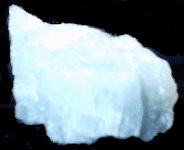
Rough aquamarine

aquamarine (beryl) on muscovite mica (not mine!) | Aquamarine is the blue, or perhaps more correctly, blue-green or aqua variety of the mineral beryl. Other gemstone colour varieties that belong to beryl include emerald, morganite, and heliodor. Other colours of beryl are simply referred to by their colour, such as red beryl. Hardness: 7.5-8. Other characteristics.
Aquamarine is coloured by trace amounts of iron that find their way into the crystal structure. Most gem aquamarines have been heat treated to produce the popular blue-green colours from less desirable yellow or pale stones. The leading producer of aquamarines is the country of Brazil, which has many mines. Pakistan, as well as many U.S. localities, produce wonderful specimens as well.
Believed to come from a mermaids tears and used by seafarers as a talisman. It helps to reconcile split partners and encourages friendships. Romans made ornaments of it to make visitors feel welcome. Healing: liver, throat, stomach, glands.
|
|
| AVENTURINE
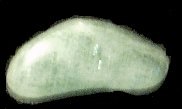
| Aventurine is a variety of quartz, with a metallic iridescence. Aventurine differs from green quartz because of the presence of small specs of mica. It can also include hematite and goethite. Hardness: 7. Other characteristics.
Enhances our self-determination, stimulates dreams, enhances relaxation. Calming. Said to encourage regeneration of the heart. Healing: eyes, migraine, tension, insomnia.
|
|
| BIOTITE
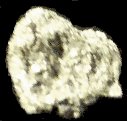
(from Vesuvius)
| A magnesiumiron mica often found in igneous rocks; it usually forms dark, almost black, crystals. Hardness: 2.5-3. Other characteristics. |
|
| BLOODSTONE

| Semiprecious stone of dark green chalcedony. Hardness: 7 Other characteristics A variety of Jasper, this stone is primarily associated with the bloodstream. It encourages acts of kindness and charity. Bloodstone was once used as an amulet in belief that it would stop bleeding. Creatures of the forest are attracted to this stone. Healing: nerves, biliousness, blood, digestion. |
|
| CALCITE
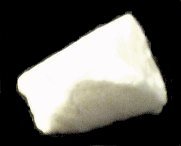
(from Vesuvius)
| Calcite, which gets its name from "chalix" the Greek word for lime, is a most amazing and yet, most common mineral. It is one of the most common minerals on the face of the Earth, comprising about 4% by weight of the Earth's crust and is formed in many different geological environments. Calcite can form rocks of considerable mass and constitutes a significant part of all three major rock classification types. It forms oolitic, fossiliferous and massive limestones in sedimentary environments and even serves as the cements for many sandstones and shales. Limestone becomes marble from the heat and pressure of metamorphic events. Calcite is even a major component in the igneous rock called carbonatite and forms the major portion of many hydrothermal veins. Some of these rock types are composed of better than 99% calcite. Why would a collector be interested in such a common mineral? Its extraordinary diversity and beauty! (more at Red calcite).
Hardness: 3. Other characteristics.
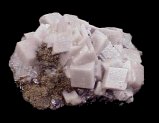
white calcite with pyrite - from the collection of and photographed by Hershel Friedman.
|
|
| CARBON SILICA
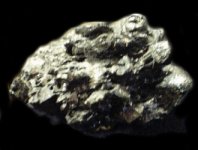
(from Vesuvius)
| Anybody know what this is? In Italian, it's Silicio di Carbonio, thus my translation. It's quite light in weight; about hardness 6. The colour is dark grey and the thick prismatic "particles" shine like obsidian. And it is obviously of volcanic origin. I thought perhaps Ilvaite. |
|
| CARNELIAN

| Semiprecious gemstone variety of chalcedony consisting of quartz (silica) with iron impurities, which give it a translucent red colour. Hardness: 7 Other characteristics Favoured by romantics to enhance sexual energy. It was reputed to guard against infertility and impotence. It concentrates the mind of those with vague and impractical thoughts. Healing: arthritis, rheumatism, neuralgia, cuts. |
|
| CITRINE

tumbled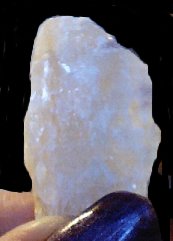
rough
| Citrine is any quartz crystal or cluster that is yellow or orange in colour. Although, often cut as a gemstone, citrine is actually somewhat rare in nature. Most citrines on the market have been heat treated. Specimens of low grade, inexpensive amethyst or smoky quartz are often cooked at high temperatures to produce the more profitable orange yellow citrine. Citrines whose colours have been produced by artificial means tend to have much more of an orange or reddish caste than those found in nature, which are usually a pale yellow. Much of the natural citrines may have started out as amethyst but heat from nearby magmatic bodies may have caused the change to citrine. Interestingly, a popular gemstone on the market is a mixture of half amethyst and half citrine and is given the name ametrine.
Unfortunately for citrine it is often confused with the more expensive orange-yellow topaz and is at times sold as topaz by unscrupulous dealers. This practice has soured many potential citrine fanciers who see citrine as a fake topaz and not as a legitimate gemstone.
Hardness: 7. Other characteristics.
Historically worn as a talisman to deter bites from snakes and other venomous creatures. It helps those who are mentally 'lost' and seem a new purpose and direction. Leaving it under the pillow at night gives pleasant dreams. Healing: skin, diabetes, circulation. |
|
| FLUORITE
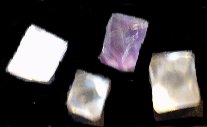
Varying shades of fluorite octahedrons from Mexico
Blue octahedral Fluorite with purple phantoming, sitting atop a matrix of Smoky Quartz and Calcite. (From the S. Curtsinger Collection. Photography by Kevin Ward)
| Fluorite, or calcium fluoride (CaF2), is a simple halide commonly occurring as a glassy, hued, vein in a variety of mineral environments. It is commonly found in metallic hydrothermal deposits associated with lead, silver, galena, sphalerite, cobalt and other economic minerals. It also occurs in cavities of pegmatites, in hot-springs areas and in sedimentary rocks, primarily limestones that have been permeated by aqueous fluoride.
One of fluorite's ingredients, the active element fluorine, is a violent poison that is also the most active of elements, capable of eating through glass and metal. Discovery and isolation of this element caused the death and permanent injury of many scientists. Another fluorine compound, hydrofluoric acid, is used to etch glass, dissolve quartz, and other minerals.
But fluorite is a harmless mineral of great beauty and variety, ranging from yellow to green to blue to red and all shades in between. It forms in lovely crystals that range from simple cubes to complex combinations showing as many as 48 faces or more.
The name flourite is from the Latin "fluere" which means, "to flow", because it melts easily and is used as a flux in the smelting of metallic ores. Fluorite is used in the manufacture of steel and hydrofluoric acid. It is a staple in one's stones used for determining hardness of other stones, because of its rating of 4. It is a relatively soft stone and can scratch or chip easily, so is rarely used in jewellery - although is a very popular stone amongst collectors. It occurs in a variety of colours, including colourless, green, blue, purple, magenta, pink, yellow, or a combination of several colours.
Hardness: 4. Other characteristics.
Fluorite offers a stabilizing energy, facilitating order, balance and healing. Excellent for clarity of mind, objectivity, concentration and meditation. Aids in grasping higher, more abstract concepts, and to be discerning as to the truth or reality of a given situation. Balances and cleanses intellectual and physical bodies. Strengthens bones and teeth and is used for dispelling illness in its early stages. Healing: Bones, teeth, inflammations. |
|
| HEMATITE
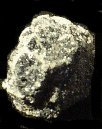
(from Vesuvius)

(tumbled)
| Hematite is iron oxide, steel grey to iron black in colour. Sometimes it has deep red spots on the surface. It is found in the United States, Brazil and Canada.
Hardness: 5-6. Other characteristics.
An aid to sports people, it provides extra energy, courage and endurance. Also alleviates travel tiedness and stress, particularly for air journeys. Healing: tiredness, travel stress, eyes, blood. |
|
| HORNBLENDE
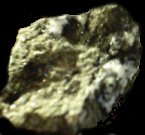
(from Vesuvius)
| This amphibole* forms prismatic crystals, often hexagonal in cross-section, and frequently twinned. It also occurs in massive, compact, granular, columnar, bladed and fibrous habits. It is green, greenish brown, or black. It forms in igneous rocks, and also found in metamorphic rock. Hardness: 5-6 *Amphibole: Group of common rock-forming minerals, often with complex composition but mostly ferro-magnesian** silicates. ** Ferro-magnesian mineral: Mineral rich in iron and magnesium. These are dense, dark-coloured silicates, sch s the olivines, pyroxenes and amphiboles. (got it? :)) |
|
| JASPER (RED)

jasper
| Opaque, impure chalcedony, usually red but also yellow, green, and greyish blue, used as a gem. Ribbon jasper has colours in stripes.
Hardness: 7 Other characteristics
A soothing stone often used as a charm against witches and other evil-doers! It is said to make the wearer more handsome or beautiful, particularly to those they wish to attract. Healing: nerves, biliousness, blood, digestion. |
|
| LAPIZ LAZULI
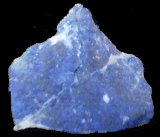
| Lapiz Lazuli is composed of lazurite, calcite, pyrite and diopside. Hardness: 5
A stone for acquiring wisdom and esoteric knowledge. Stone of protection. Regarded as a heavenly stone in ancient times for its apparent unearthly quality. It completely refreshes the spirit and creates a pure, ethical atmosphere.
Healing: Bones, heart, eyes. |
|
| LAVA

(from Vesuvius)
| Cooled magma from a volcanic eruption. This lava was collected from the crater of Vesuvius - and the hub nearly fell in!! 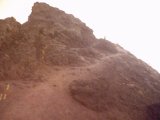 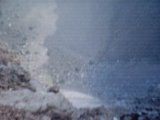

Your intrepid geologist/explorer/tourist complete with obligatory baggy, khaki "shorts"!All sorts of questions about lava. |
|
| LEPIDOLITE
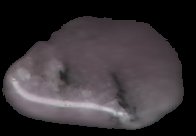
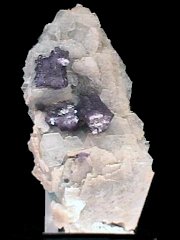
lepidolite au natural (resting on crystalline albite)
No, of course not mine! | Lepidolite. Potassium lithium aluminum silicate hydroxide fluoride. Lepidolite is an uncommon mica and has only in the past decade become available on the mineral market in large quantities. Lepidolite is an ore of lithium and forms in granitic masses that contain a substantial amount of lithium. The lithium content in lepidolite does vary greatly however and low lithium lepidolite is nearly useless as an ore of lithium. The typical violet to pink color of lepidolite is characteristic and is the only field test available to identify lepidolite from other micas. Pink muscovite or very pale lepidolite may confuse an identification.
Lepidolite, like other micas, has a layered structure of lithium aluminum silicate sheets weakly bonded together by layers of potassium ions. These potassium ion layers produce the perfect cleavage. lepidolite crystals accompany such other lithium bearing minerals such as tourmaline, amblygonite and spodumene and can add greatly to the value of these specimens. A rock made of granular pink lepidolite and red to pink tourmaline is used as an ornamental stone for carving. Single large plates or "books" of lepidolite can have appealling violet color and make attractive mineral specimens. Hardness: 2.5-3.
The 'Junkies Friend', lepidolite has a high lithium content making it an excellent balancer, allowing a gentle withdrawal from compulsive behaviour. It aids the strengthening of the muscles of the heart and blood flow while giving expression to your innate inner light and joy.
|
|
| MALACHITE
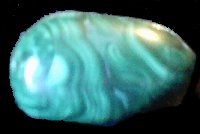
tumbled
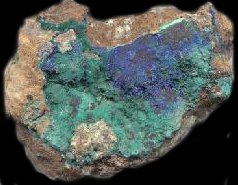
malachite with azurite
| PSEUDOMORPHS (often occurs with malechite and azurite, for example - although not in the above sample). (Thank you to John Betts for this)
"Pseudomorphs are mineral specimens where the mineral has taken the form of a previously deposited mineral. Sounds simple, but the processes are diverse and elaborate. Some are created when a second mineral grows over another, then the original dissolves away. Some are replaced molecule by molecule, or atom by atom, until the second mineral has the exact shape of the original mineral. Sometimes a mold is made of the first mineral by a second mineral growing over it, then the original dissolves, then a third mineral fills the void, and finally the second mineral dissolves. Suffice it to say you could collect just pseudomorphs and have an endless variety of specimens." |
|
Malachite (Cu2CO3(OH)2) is a carbonate, which are among the most widely distributed minerals in the Earth's crust. Carbonate minerals other than simple carbonates include hydrated carbonates, bicarbonates, and compound carbonates. Malachite is a member of this third group, as are the minerals, bastnäsite, doverite, and azurite.
Malachite is a secondary mineral of copper, which means it is formed when copper minerals are altered by other chemicals. It occurs when carbonated water interacts with copper minerals, or when a solution of copper interacts with limestone. Malachite is opaque and always green. Because of its presence in nearly all oxidized copper deposits, malachite serves as a prospecting guide for copper.
Malachite crystals sometimes form as needles that fan out from the rock in which they are embedded. More often, malachite forms as a mass with concentric bands of light and dark green. Such specimens are almost always internally banded in different shades of green, and can be seen when a specimen is polished or cut open. When, the bands consist of concentric rings, specimens are highly prized.
Because of its beauty and relative softness, polished, banded Malachite has been carved into ornaments and worn as jewelry for thousands of years. In some cultures it was thought to be a protection from evil if worn as jewelry. Malachite has also been widely used as an ornamental stone. In Czarist Russia it was used to make the columns of St. Isaac's Cathedral in Leningrad. The original material, from which ornaments and jewelry were made since the earliest times came from an enormous deposit in the Ural Mountains of Russia, where massive globular specimens were found.
Malachite is still very popular among mineral collectors, especially interestingly shaped and banded specimens. It is also used as an ore of copper and crushed to make a green pigment. Malachite is usually found with azurite, a blue secondary mineral of copper, but its more widespread and abundant. Some mineral samples have alternating bands of green malachite and blue azurite, forming what is commonly known in the gem and mineral trade as Azure-malachite.
Hardness: 3 1/2 - 4
(The specimen below, left is one which I have, only today, purchased by auction - all I must do is pay for it! I hope the owner won't mind me showing the picture).
Stone of balance and transformation. Brings to understanding processes in one's life and body, assisting in one's spiritual evolution. Stimulates intuitive power, making one more open to change and advancement. Malachite also represents fidelity, loyalty, practicality, and responsibility. Allows for insight into emotional factors that may be manifesting as physical illness. It is known for protection against radiation and for strengthening immune system. Eases delivery in birthing, and also facilitates the re-birthing process, as it helps one to recognize and clear past negative experiences.
|
|
| BLACK MICA
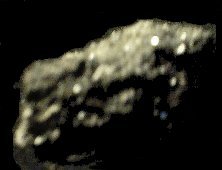
(from Vesuvius)
| The general formula for mica is AB2-3 (Al, Si)Si3 O10 (F, OH)2. In most micas the A is usually potassium, K, but can be calcium, Ca, or sodium, Na, or barium, Ba, or some other elements in the rarer micas. The B in most micas can be aluminum, Al, and/or lithium, Li, and/or iron, Fe, and/or magnesium, Mg. The mica group is a large group with nearly 30 members recognized, but only a few are common. Those few however make up a large percentage of the most common rock types found in the Earth's crust.
So there you go!! The Biotite, above, is a type of mica too. |
|
| MIMETITE
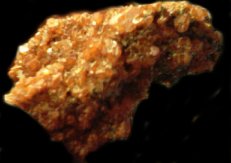
(from Vesuvius)
| Pb5(AsO4)3Cl, Lead Chloroarsenate
From the Greek mimethes - "imitator", alluding to its ressemblance to pyromorphite
Mimetite is a rare secondary mineral found in the oxidized portions of lead deposits. It is typically associated with cerusite, plattnerite, wulfenite, smithsonite, hemimorphite, anglesite, limonite and other oxide zone minerals. Structurally, mimetite is a member of the apatite group; an end-member of the pyromorphite-mimetite series. It's given as belonging to the monoclinic crystal system in some references.
It occurs as colorless to yellow-brown or orange hexagonal, prismatic crystals which sometimes exhibit curved faces, and also as rounded, globular forms.
Hardness: 3 1/2
|
|
| OLIVINE
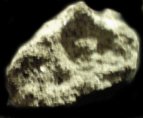
(from Vesuvius)
| (Mg,Fe)2SiO4
The minerals compromising the Olivine group are chemically and physically similar, and it is very hard to distinguish one from the other. Therefore, these minerals are rarely called by their real name, but are just called "Olivine".
Olivine is a very common mineral, but it rarely occurs in sizes larger than microscopic grains. For this reason, larger specimens are rare and sought after. Only few localities yield large examples of this mineral, although small grains are found worldwide. Olivine is also found in meteorites, and some large grains have been reported in many of them.
Olivine occurs worldwide, but only few places yield large crystals. The finest Peridot (a green, transparent gem variety) comes from St. Johns Island (Zebirget) in the Red Sea off Egypt. Other Peridot localities include Mogok, Myanmar (Burma); Soppat, Kohistan province, Pakistan; the Ural Mountains of Russia; Snarum, Norway; Mt. Vesuvius, Italy; and the Eifel District, Germany.
Hardness: 6 1/2 - 7 |
|
| OREGON OPAL

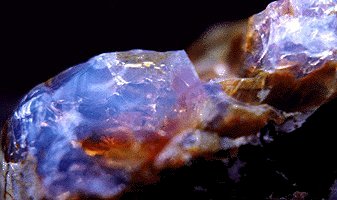
a close-up of a piece of rough Oregan opal as (was) available from www.bestcrystals.com - mine is like this, only smaller!(more on opals + photos) | This is a unique variety of opal found in Northeastern Oregon, which was discovered by a shepherd 100 years ago.
Tiffany's originally marketed this opal, which became an avidly sought-after stone, at the turn of the century. This material is hand mined at Opal Butte.
Unlike Australian opal, Oregon Opal exhibits translucent shades of blue, yellow, red, and sometimes iridescent "fire". Its luminescence glows as if it came from another dimension. Hardness: 4.5-6.5. Other characteristics. Metaphysically it acts as a conduit to the joyful side of the emotional experience. "Oregon Opal allows for the joyful release and expression of the emotions and the imagination. This stone encourages one to act upon one’s desires in a loving way. Unlike some opal, which can facilitate the experience of the more difficult emotion. Oregon Opal connects one to the joyful side of the emotional experience, while enabling one to integrate and release old wounds in the emotional body.
While other Opals are related to the Water Element, Oregon Opal is related to the fire element, and so encourages one to transmute any negativity that one may encounter into useful energy that can be utilized in positive ways."
The fiery colour of Oregon Opal relates to the second chakra, our reproductive centre or place of creation/creativity. A wonderful crystal to stimulate creativity, manifestation and activate the Used by healers to cure: energy from the center of the earth and the rays of the sun. This stone has been used by shamans to access the dreamtime and further the progress of the dreams toward reality.
(I love this and intend to get another! One of the Austalian Boulder variety wouldn't go amiss either!
|
|
| OBSIDIAN
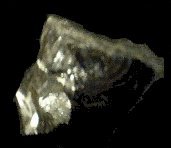
ossidiana (from Vesuvius, ossidiana)

obsidian lodged in perlite - this type being what is known as "apache tears" (not mine!)

But this one is mine! From Colorado - a gift from a friend. I hope you can appreciate the transluscence, as I have it held against the light. It's not true about what they say about "never crying again", by the way! |
Obsidian, a volcanic glass, usually of rhyolitic composition, forms by rapid cooling of a viscous lava. Most obsidians are more than 70 percent silica and are low in volatile contents. Microscopic crystals of quartz or feldspar are sometimes included in the glass. Obsidian occurs as thick, short flows or domes over volcanic vents. It is usually black in colour but occasionally red or brown (if iron-oxide dust is present), clear, or green. Obsidian displays a well developed conchoidal fracture, which makes it an excellent material for arrowheads, knives, and other sharp tools and weapons. Archaeologists use obsidian tools to trace trade routes, because such tools are relatively rare and each occurrence has a slightly different chemical composition. Thus the source of primitive obsidian tools may be located even if the tools have been traded across thousands of kilometers.
Obsidian has also been used as a semiprecious gem because of its shiny luster. Perlite, a hydrous form of obsidian, is used as a lightweight aggregate. When heated it expands into an artificial pumice like material. Its potential expansion after transport is a major shipping advantage. The rounded nodules of obsidian left after hydration and alteration of surrounding material into perlite are known as Apache tears. Looking like black teardrops, they are collector's items in the American Southwest. Now used in rock wool. Hardness: 6-7.
A stone of achievement for those working to a goal in their life. It creates positive influences to overcome problems and provides inner tranquility to ease stress symptoms. An excellent general healer. Those who possess an "Apache tear" are said to never cry again! "A telephone line to the soul! This stone connects with the "inner you" and brings out your best attributes. Also develops an affinity with horses."
|
|
| PYRITE
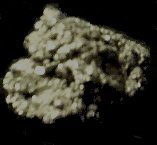
(from Vesuvius)
| Pyrite is the classic "Fool's Gold". There are other shiny brassy yellow minerals, but pyrite is by far the most common and the most often mistaken for gold. Whether it is the golden look or something else, pyrite is a favourite among rock collectors. It can have a beautiful lustre and interesting crystals. It is so common in the earth's crust that it is found in almost every possible environment, hence it has a vast number of forms and varieties. A very minor ore of sulphur for sulphuric acid, used in jewellery under the trade name "marcasite" and as mineral specimens. Hardness: 6-6.5. Other characteristics.
Used for focus, practicality, logic, memory, scatteredness. Like Hematite, helps stomach, intestines, ulcers; sulphur & mineral assimilation, circulation, body acidity imbalances. |
|
| PEACOCK ORE

| Also known as Bornite; copper iron sulphide. The very beautiful purple, blue, green and red irridescence is caused by tarnishing. Hardness: 3 Other characteristics.
Stone of happiness. Provides insight. Wards off negativity. Excellent healing stone, helps align cellular growth. Encourages magical, imagination that leads to new directions, hope, and trust. Protection from negativity. Helps heal the cellular structure, nervous system, lungs, and heart. Attunes to all chakras. |
|
| PETRIFIED WOOD
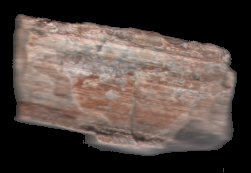
from the NW United States
| (Fossil - perhaps 250 millions years old!). Petrified wood has been preserved for millions of years by the process of petrification . This process turns the wood into quartz crystal which is very brittle and shatters. Even though petrified wood is fragile, it is also harder than steel.
The process of petrification begins with three raw ingredients: wood, water and mud. Petrification of wood found began during the Triassic Period when the primitive conifers fell to the ground and into the waterways on a journey through time. The logs were swept and tumbled downstream with sediment and other debris. The streams travelled through a plain of lakes and swamps where wood, sediment and debris were deposited along the way.
|
|
| PUMICE

(from Vesuvius)
| This is a light, porous rock with the composition of rhyolite. Pumice usually tends to be used as a textural term - applied to vesiculated lavas that may resemble froth or foam. This rock has a highly scoriaceous texture, with many hollows and cavities. The vesicles may join to form elongated passages and tubes throughout the rock. Zeolites may fill these cavities. The density of pumice is so lo9w that it can easily float in water. It forms as frothy lavas associated with rhyolitic volcanic eruptions. When erupted into the sea, patches may drift for great distances. Pumice can also be formed by land-bound volcanic eruptions. |
|
| QUARTZ

(from Brazil)
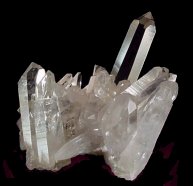
a most desirable clump of quartz crystals, which does not belong to moi! | Quartz is the most common mineral on the face of the Earth. It is found in nearly every geological environment and is at least a component of almost every rock type. It frequently is the primary mineral, >98%. It is also the most varied in terms of varieties, colours and forms. This variety comes about because of the abundance and widespread distribution of quartz. A collector could easily have hundreds of quartz specimens and not have two that are the same due to the many broad catagories. The specimens could be separated by answers to the following questions: colour?, shade?, pyramidal?, prismatic?, druzy?, twinned?, sceptred?, tapered?, phantomed?, inclusions?, coated?, microcrystalline?, stalactitic?, concretionary?, geoidal?, tappered?, banded?, etc. Multiple combinations of these could produce hundreds of unique possibilities. Hardness: 7. Other characteristics.
Perhaps the most popular of all stones. It purified the air and the body, cleansing the system and clearing the mind. Healing: vertigo, dizziness.
|
|
| RED CALCITE
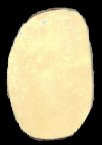
| With calcite so abundant and so widely distributed it is no wonder that it can be so varied. The crystals of calcite can form literally a thousand different shapes by combining the basic forms of the positive rhombohedron, negative rhombohedron, steeply, moderately and slightly inclined rhombohedrons, various scalahedrons, prism and pinacoid to name a few of the more common forms. There are more than 300 crystal forms identified in calcite and these forms can combine to produce the thousand different crystal variations. Calcite also produces many twin varieties that are favourites among twin collectors. There are also phantoms, included crystals, colour varieties, pseudomorphs and unique associations. There simply is no end to the varieties of calcite. Hardness: 3. Other characteristics.
Provides comfort and consolation for those in emotional crises. It refreshes the system and gives new inspiration when you are a little "down! Used by healers to cure : bladder, pancreas.
|
|
| RED LAVA

(from Vesuvius)
| (See ordinary lava above.) |
|
| RHODOCHROSITE
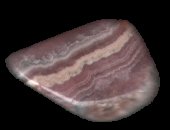
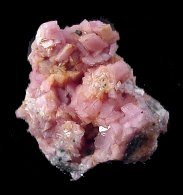
Here's how natural rhodochrosite looks. Perty ain't it? I aim to get some! | Rhodochrosite. Manganese carbonate.
Rhodochrosite (whose name means rose-colored) is a very pretty mineral. In a massive form its pink and white bands are extremely attractive and are often used in semi-precious jewelry. Rhodochrosite is often carved into figurines and tubular stalactitic forms are sliced into circles with concentric bands that are truly unique in the mineral kingdom. Fine crystals are sometimes cut into gemstones, but rhodochrosite's softness and brittleness limit its use as a common gemstone. Left alone, crystal specimens of rhodochrosite can be admired and cherished for their unique color and beauty. Hardness: 3.5-4. Other characteristics.
The 'Brave Stone', rhodochrosite helps to blend courage, passion and willpower, giving the fortitude to overcome emotional trauma and mental breakdown. Also aids the spleen, kidneys, heart and blood circulation while enhancing memory and intellectual strength. Helps you to cope with the stress of modern living. |
|
| ROSE QUARTZ
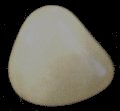
tumbled
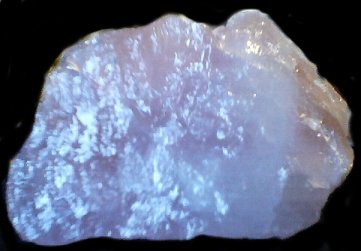
large rough piece
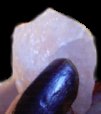 and a smaller rough bit and a smaller rough bit
| Translucent pink silicon dioxide (i.e. quartz). The rose colour comes from the trace mineral Titanium. Hardness: 7. Other characteristics.
The stone of peace and goodwill. It is closely associated with Venus, giving joy and happiness in friendship and love. The wearer also "feels good" and radiates forgiveness and rapport. Healing: migraine, headache, wounds.
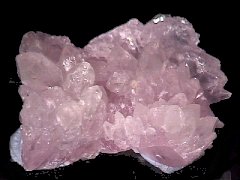
rose quartz as it grows and illustrating its true colour. |
|
| SNOWFLAKE OBSIDIAN
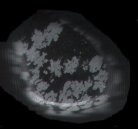
| Snowflake Obsidian: see "obsidian" above. Obsidian is a very shiny natural volcanic glass. When obsidian breaks it fractures with a distinct conchoidal fracture. Notice in the photo to the left how it fractures. Obsidian is produced when lava cools very quickly. The lava cools so quickly that no crystals can form.
When people make glass they melt silica rocks like sand and quartz then cool it rapidly by placing it in water. Obsidian is produced in nature in a similar way. Hardness: 6-7.
|
|
| SNOWY QUARTZ

| More silicon dioxide (quartz).
Hardness: 7. Other characteristics.
A very 'soft' stone, exuding tranquility and quietness. For those seeking a calm serenity. It's mellow nature inspires spiritual and devotional qualities. Healing: stress, nerves. |
|
| SODOLITE
 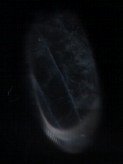
a lump bought on the Isle of Skye (as September's birthstone!?) and a tumbled stone
| Sodalite. Na8Al6Si6O24 Cl2. Composed of quartz and Silocon Dioxide, Sodalite is one of the prime constituents of sodalite syenite. Opaque dark blue, one of the components of lapis lazuli. Often included with white streaks of calcite. Hardness: 7.
Gives confidence to those who are shy or introvert, allowing assurance and free expression when with others. It is therefore particularly suited to teachers, actors and performers. Also a meditation stone. Healing: Blood Pressure, Sleep, Chest.
|
|
| SULPHUR
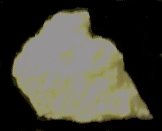
(from Vesuvius)
| Well, sulphur! Crumbly, yellow, smelly stuff! Hardness: 1.5-2.5. Other characteristics. |
|
| TIGER'S EYE

tumbled

and rough | Tiger's Eye is a brown quartz silicon dioxide with lustrous yellow and brown parallel fibres. The yellow-gold colours are due to iron oxides. Tiger's Eye has the property of chatoyancy, which means that it glitters with a small ray of light on the surface, much like the eyes of a cat. The largest deposits of tiger's eye are in South Africa, Australia, Burma, India and the United States.
This common form of quartz has been popular in jewelry making for years. It comes in various shades of light or dark brown and has fibrous inclusions that add a luminosity to the stone. If the stone is cut properly, it resembles a females cat's eye. Hardness: 7 Other characteristics
Tiger's Eye is a stone which reflects light by virtue of its fibrous nature. It occurs in colours including red, gold, brown, cream, blue and black.
Tiger's Eye helps clarity of thought, assisting in thinking practically. It eliminates negative thought and instils optimism, and addresses conflicts associated with wilful pride.
It brings awareness of ones own needs, as well as the needs of others, distinguishing between 'wishing' and 'having', and determining the 'need'.
Tiger's Eye is soothing and brings calmness to unresolved turmoil, removing artificial barriers and inhibitions. Healing: hypochondria, asthma, limbs.
|
|
| VESUVIANITE
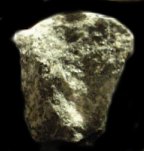
(from Vesuvius)
| Also known as idocrase, this mineral forms short prismatic and pyramidal crystals. A semi-precious gemstone when transparent, vesuvianite was discovered at Mount Vesuvius, Italy. It forms in impure limestones that have been altered by contact metamorphism. It also occurs in some igneous rocks, including nepheline syenite. Hardness: 6-7 |
|
| WULFENITE
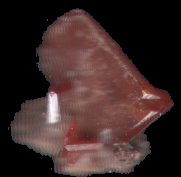
wulfenite from the Red Cloud Mine, USA
| Lead Molybdate. Wulfenite is a nice collection type mineral and is popular as such. Its strong colours, nice lustre and one-of-a-kind crystal habits attract the attention of many collectors around the world. This very small sample of Wulfernite came from the Red Cloud Mine, Arizona, USA. Wulfenite mined there had a distinct colour. The mine is now, unfortunately, closed and so pieces like this will become increasingly rarer. Hardness: 3. Other characteristics. 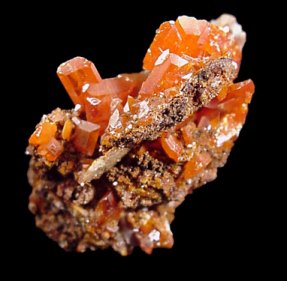
a slightly bigger clump of wulfenite from the Red Cloud Mine than mine! |
|
| MUST HAVE!! TUGTUPITE
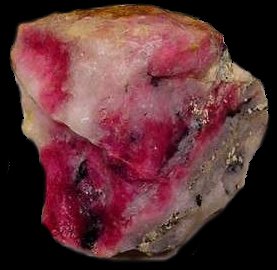
| Na4BeAISi4O12CI This very specimen of tugtupite is currently for sale at eBays auctions. I can't afford it right now - but I'll keep on looking! How fascinating it is - and how RARE! Tugtupite was first discovered in 1960 in Greenland, where it is carved for jewellery. It's found as massive aopaque material in pegmatite veins. Hardness: 6 Once upon a time in Greenland, the girl Tuttu (reindeer) wanted to give birth in solitude, so she went into the mountains. Her blood and placenta fell to the ground and there appeared the tuttupit stone.
Only a few kilometres outside Narsaq, Greenland, it is possible to find minerals and stones that are totally unique to that area, and others that are rare and only found few other places in the world. This is due to a very special geological phenomena, called an intrusion.
An intrusion can briefly be described as a volcano that never reached the surface. Thus the lava hardened under ground in a huge lava-chamber, and formed rare minerals and stones due to the particular pressure and temperature conditions.
This has made Narsaq a paradise for geologists, who has found uranium, sodalite and the treasured and beautiful Tugtupit stone. Many of the stones found in the area respond to warmth, so the lucky purchaser or finder of a tugtupit stone should hold it firmly in the hand or expose it to sunlight, and will then learn that the rather pale red stone suddenly turns into a beautiful dark red gem.
 | For ages, the Inuit of Greenland have understood the power of Tugtupit. Legend has it that lovers can cause the stone to glow fiery red just from the heat of their romance. The brilliance and vibrant colors announce the intensity of their love.
|

Read more here at the home of Peter Lindberg, who could well be my saviour!
|
This isn't mine either - but I WISH!!
Wulfenite from Mexico! Pizza anyone??
Catch many more beautiful minerals like this at the photographic pages of 
(I hope he doesn't mind me using a couple of his photos on this page)
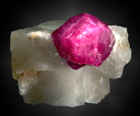 | For some photographs of minerals OUT OF THIS WORLD, click on the ruby! (Make sure to look at the full-size photos). You will never be able to afford them, but they are just sensational to look at!! |
 Have a look at these too!! (The TOP ILLUSTRATION was borrowed from here. Thank you Stuart Wilensky. He names that piece, "Wulfenite Surprise"
and it comprises Dioptase with Mimetite on Wulfenite from the San Francico Mine, Cucurpe, Mexico)
| Hall of Fame Oh, wow! I don't think I'll ever have enough of looking at these things! These are just fabulous!! | 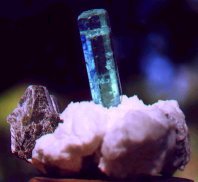 |

This is where I often shop - and they are infinitely less expensive, but the quality of goods and service is excellent! Also, the postage (even from the USA to the UK) is very reasonable. Highly recommended - these people love their rocks!
 Likewise, here.
 This is probably the best UK site I've come across. Greg also has a market stall (stall number 3) in Plymouth's panier market.

Go visit Dale in Idaho! He makes some superb jewellery from the stones he mines and cuts - and even the gold he pans!
 | And this is a very nice site in Australia. I am tempted by their "Trinityite", which is "fused sand from the first atomic blast." Whoa! |

Extremely interesting and educational. Metiorites too!
  This, though is the bees knees! Absolutely everything - I mean EVERYTHING - you ever want to know about hundreds of different types of gems and minerals. Loads more pics too! Awesome!!
 Want loads more links? Check this out if you have a few hours to spare!
[ back to my room ] [ smells ] [ fairies ] [ artefacts ] [ other things ] [ home ]
|






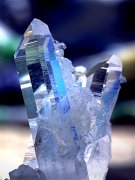
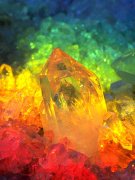
































































 and a smaller rough bit
and a smaller rough bit












